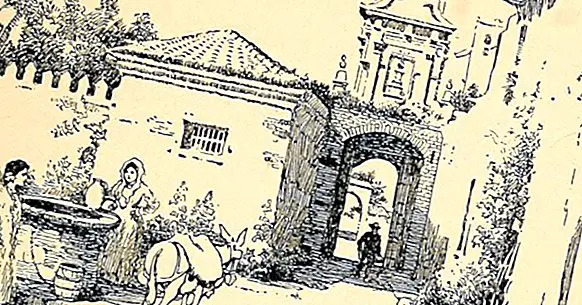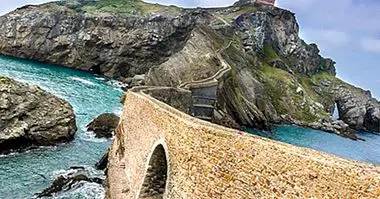The 10 best Spanish legends (old and current)
The legends are literary compositions that narrate imaginary events, whose base can have historical data, fantastic characters, supernatural phenomena, among other elements. For this reason, legends involve values, evoke emotions, interpret experiences, denounce or justify actions, explain phenomena of nature and are, above all, resistant to change: they are transmitted from generation to generation mainly through the spoken word.
In addition to the rich symbolic content, useful to know the idiosyncrasy of a particular culture, legends have an important potential for shared entertainment. In this article we will see specifically 10 of the most popular Spanish legends .
- Related article: "The 10 best short legends (for children and adults)"
The 10 most popular Spanish legends
There are numerous legends around the 19 autonomous communities that are part of Spain. Some of them are the product of stories of love and lack of love, others help explain seemingly supernatural phenomena, and others go back to times as old as the Middle Ages .
It is precisely its mystical and symbolic content that has allowed these narratives to endure over time. Then 10 of the most representative legends from different Spanish locations.
1. The lovers of Teruel
To the east of Spain, in the community of Aragon, is the city of Teruel. One of the most representative churches of this town was renovated in the sixteenth century. During its remodeling, two mummified bodies were found and accompanied by a document that describes, in the words of Judge Domingo de Celada, the following: the bodies belonged to Isabel Segura and Juan Diego de Marcilla, whose infatuation had been impeded by their families .
The condition to be together was that Diego de Marcilla was enriched, so he decided to go to make money and time after returning for Isabel. In the course, the father of Isabel looked for another husband to him, with who married the same year in which Diego de Marcilla returned.
The impact of the latter was so great that he fell dead when he found out. At the funeral, Isabel gave him one last kiss, as a sign of guilt and reconciliation. In doing so, she fell dead on the body of Juan Diego. To the surprise, the relatives decided to bury them together as a symbol of a late approval of his love.
2. The Mosque of Cordoba
In the city of Córdoba, in the community of Andalusia, it is said that a young Christian bought flowers from his girlfriend, a beautiful young woman of Muslim origin. When asking for her marriage, she also accepted to convert to Christianity, but her intention was impeded by soldiers who murdered her on the same day she would be baptized.
As a cast, these soldiers chained the young man on the pillars of a mosque . While he was chained, the young man shaped a small cross with his fingernail, which to this day can be seen in the marble of the column where he spent the rest of his days.
3. The island of San Borondón or San Brandán
Legend has it that the Canarian archipelago, located off the northwest coast of Africa, has an island that constantly appears and disappears. This island owes its name to San Brandán de Clonfert, better known as San Borondón, an Irishman who crossed the Atlantic Ocean for evangelical purposes.
Upon arriving on the island, I quickly defined it as an earthly paradise. But it turned out that other navigators could hardly locate it. It was an island that some claimed to have visited, while others, by directing by the same indications, could not reach the destination. Later the mysterious disappearance of the island was attributed to the thick fog that covers the region ; reason why it is known until today as "the lost island" "the enchanted island" "the hidden island", among others.
4. The Badajoz ravine
On the island of Tenerife, in the autonomous community of Canarias, there is a ravine known as the Barranco de Chamoco, or Barranco de Badajoz. It is a large canyon that, according to legend, has witnessed the presence of extraterrestrials, or angelic beings. There is even talk of satanic rituals and paranormal phenomena to which some studies have been dedicated.
The above comes from different lights and figures whose origin has not been explained by the neighbors. Some disappearances have also been attributed to him ; so much so that, some specialists in paranormal phenomena, have attributed to the Barranco de Badajoz activity similar to that attributed to the popular American Triangle of Bermuda.
5. The devil's cross of Cuenca
In the city of Cuenca, located in the autonomous community of Castilla-La Mancha, lived a young man so seductive that he managed to conquer any woman who proposed. His gifts were questioned before the arrival of a foreign woman named Diana, which was attractive to men and women alike .
Near the dates of all saints, the young man received a letter from Diana where he quoted him in the Hermitage of Cuenca. As soon as her physical approach to her began, Diana was transformed into a terrifying figure who laughed out loud and resembled the devil himself.
Fear of fear, the young man ran to a cross located outside the hermitage, and hugged her tightly. The devil persecuted him and immediately he launched himself towards the young man, managing to leave a mark on the cross that can be appreciated to this day. This is one of the most disturbing Spanish legends.
6. The Witches of Zugarramurdi
On this popular legend there are different versions. All refer to some witches and sorcerers who lived in the municipality of Zugarramurdi, in the province of Navarra. ANDThese gathered to worship a goddess of the earth that existed in different caves and meadows in the areas.
In addition, the legend tells that they praised the protective spirits that made women possessing various supernatural powers. This spirit was called Akerbeltz, which means "goat" in Euskera. For the same reason, the meetings in these caves were called Akelarre, which means "meadow of the bastard."
7. The curse of Ochate
There is in the city of Burgos an unpopulated town called Ochate, which today is known to many as a cursed town. Legend has it that this town is the site of numerous paranormal events after having gone through three tragedies .
The first was the smallpox epidemic of 1860, where only 12 people survived in the same locality. Years later, the population recovered, but immediately, they were prey to a deadly typhoid epidemic. Finally, and after having recovered again, an epidemic of cholera ended up destroying the last inhabitants. What gave rise to the legend of Ochate's curse is that, coincidentally, none of the neighboring towns and villages had gone through these same tragedies.
8. The faces of Bélmez
Beginning in the 1970s, pigmentations began to appear on the walls and floors of a house located in Bélmez de la Moraleda, in the autonomous community of Andalucía, province of Jaén. These pigmentations took the shape of human faces, bodies and skeletons .
In spite of the attempts of the inhabitants to cover them with cement and other materials, these pigmentations, to this day continue to appear. Legend has it that these apparitions correspond to the bodies buried in the Arab medieval cemetery found in the basement of the house, approximately 3 meters deep. So, the faces of Bélmez they have not only become an important Spanish legend, but a topic of conversation among lovers of mystery .
9. Lake Banyoles
In the province of Girona, located in Catalonia, there is a lake called Estany de Banyoles, which is the largest in the whole community and one of the largest in Spain. As in Loch Ness, the legend tells that in the Bañolas there is a monster in the shape of a dragon (it has thick skin, spikes, wings, fangs, big legs). There have been several attempts to find and kill him, from Charlemagne to an emperor with the help of the French Minister San Emeterio .
Likewise, the neighbors said that this dragon is responsible for the disappearances of cattle, floods and earthquakes. In more recent times, disappearances of tourists and even planes are attributed to this monster.
10. The castle of Malmuerta
In the city of Córdoba, community of Andalusia, there is a castle with a high tower called "Torre de la Malmuerta". They say that in the fifteenth century, an aristocratic man fell in love with a beautiful young woman, who could have been his granddaughter .
Also interested in man, the woman accepts her marriage proposal. But it was a woman highly coveted by other men, many of them younger than the aristocrat. This aroused in the future husband jealousy obsessive that finally led him to end the life of his beloved.
The judges determined that the young woman had been "malmuerta", victim of the unjust acts of her husband, who was sentenced to sell all his property and to erect a tower called "torre de la malmuerta" in the house where he had committed the crime, in honor of the woman and as a sign of repentance.



















